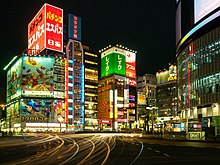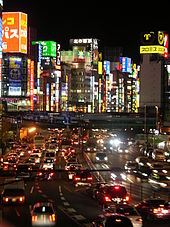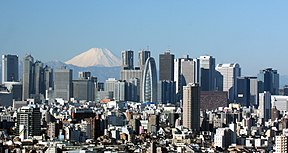Shinjuku
This article has multiple issues.Please helpimprove itor discuss these issues on thetalk page.(Learn how and when to remove these template messages)
|
Shinjuku
Tân túc khu | |
|---|---|
| Shinjuku City[1] | |
Clockwise from top:
| |
 Location of Shinjuku inTokyo | |
| Coordinates:35°42′5″N139°42′35″E/ 35.70139°N 139.70972°E | |
| Country | Japan |
| Region | Kantō |
| Prefecture | Tokyo |
| Government | |
| • Mayor | Kenichi Yoshizumi |
| • Tourism Ambassador | Godzilla[2] |
| Area | |
| • Total | 18.23 km2(7.04 sq mi) |
| Population (1 October, 2020[3]) | |
| • Total | 349,385 |
| • Density | 19,000/km2(50,000/sq mi) |
| Time zone | UTC+9(Japan Standard Time) |
| - Tree | Zelkova serrata |
| - Flower | Azalea |
| Phone number | 03-3209-1111 |
| City Hall Address | Kabukichō 1-4-1, Shinjuku-ku, Tokyo 160-8484 |
| Website | www |
Shinjuku(Japanese:Tân túc khu,Hepburn:Shinjuku-ku,IPA:[ɕiɲdʑɯkɯ]),officially calledShinjuku City,is aspecial wardofTokyo,Japan.It is a major commercial and administrative center, housing the northern half of the busiest railway station in the world (Shinjuku Station) as well as theTokyo Metropolitan Government Building,the administrative center of theTokyo Metropolitan Government.As of 2018[update],the ward has an estimatedpopulationof 346,235 and apopulation densityof 18,232 people per km2.The total area is 18.23 km2.[4]Since the end ofWorld War II,Shinjuku has become a major secondary center of Tokyo (fukutoshin), rivaling the original city center inMarunouchi.
"Shinjuku" is also commonly used to refer to the entire area surroundingShinjuku Station.The southern half of this area and of the station are in fact located in neighboringShibuyaward.
History[edit]

In 1634, during theEdo period,as the outer moat of theEdo Castlewas built, a number of temples and shrines moved to the Yotsuya area on the western edge of Shinjuku. In 1698, Naitō-Shinjuku had developed as a new (shin) station (shuku or juku) on theKōshū Kaidō,one of the majorhighwaysof that era. Naitō was the family name of adaimyōwhose mansion stood in the area; his land is now a public park, the Shinjuku Gyoen. In 1898, the Yodobashi Water Purification Plant, the city's first modern water treatment facility, was built in the area that is now between the park and the train station.[5]
In 1920, the town of Naitō-Shinjuku, which comprised large parts of present-day Shinjuku (the neighborhood, not the municipality), parts ofNishi-ShinjukuandKabukichōwas integrated intoTokyo City.Shinjuku began to develop into its current form after theGreat Kantō Earthquakein 1923, since the seismically stable area largely escaped the devastation. Consequently, West Shinjuku is one of the few areas in Tokyo with manyskyscrapers.
TheTokyo air raidsfrom May to August 1945 destroyed almost 90% of the buildings in the area in and around Shinjuku Station.[6]The pre-war form of Shinjuku and the rest of Tokyo was retained after the war because the roads and rails, damaged as they were, remained, and these formed the heart of the Shinjuku in the post-war construction. Only in Kabuki-cho was a grand reconstruction plan put into action.[7]
The present ward was established on March 15, 1947 with the merger of the former wards of Yotsuya, Ushigome, and Yodobashi. It served as part of theathletics50 km walk and marathon course during the1964 Summer Olympics.[8]In the 1970s, the Yodobashi Water Purification Plant closed and was replaced by skyscrapers.[9]
In 1991, the Tokyo Metropolitan Government moved from theMarunouchidistrict ofChiyodato the current building in Shinjuku (theTokyo International Forumstands on the former site vacated by the government).
Geography[edit]

Shinjuku is surrounded byChiyodato the east;BunkyoandToshimato the north;Nakanoto the west, andShibuyaandMinatoto the south.[10]

The current city of Shinjuku grew out of several separate towns and villages, which have retained some distinctions despite growing together as part of the Tokyo metropolis.
- East Shinjuku (or administratively called Shinjuku, Shinjuku-ku): The area east ofShinjuku Stationand surroundingShinjuku-sanchome Station,historically known as Naito-Shinjuku, houses the city hall and the flagshipIsetandepartment store, as well as several smaller areas of interest:
- Kabukichō:Tokyo's best-known red-light district, renowned for its variety of bars, restaurants, andsex-related establishments.
- Golden Gai:An area of tiny shanty-style bars and clubs. Musicians, artists, journalists, actors and directors gather here, and the ramshackle walls of the bars are plastered with film posters.
- Shinjuku Gyo-en:A large park, 58.3 hectares, 3.5 km in circumference, blendingJapanese traditional,English landscapeandFrench formalstyle gardens.
- Shinjuku Ni-chōme:Tokyo's best-knowngaydistrict.
- Nishi-Shinjuku:The area west of Shinjuku Station, historically known as Yodobashi, is home to Tokyo's largest concentration ofskyscrapers.Several of thetallest buildings in Tokyoare located in this area, including the Tokyo Metropolitan Government Building, KDDI Building andPark Tower.
- Ochiai: The northwestern corner of Shinjuku, extending to the area aroundOchiai-minami-nagasaki Stationand the south side ofMejiro Station,is largely residential with a small business district aroundNakai Station.
- Ōkubo:The area surroundingOkubo Station,Shin-Okubo StationandHigashi-Shinjuku Stationis best known as Tokyo's historic ethnic Korean neighborhood afterWorld War II.
- Totsuka: The northern portion of Shinjuku surroundingTakadanobaba StationandWaseda University,today commonly referred to as Nishi-Waseda. TheTakadanobabaarea is a major residential and nightlife area for students, as well as a commuter hub.
- Toyama:A largely residential and school area, in the east of Ōkubo and south ofWaseda University,extending to the area aroundNishi-Waseda Station,Gakushuin Women's Collegeand Toyama Park.
- Ushigome:A largely residential area in the eastern portion of the city.
- Ichigaya:A commercial area in eastern Shinjuku, site of theMinistry of Defense.
- Kagurazaka:A hill descending to theIidabashi Stationarea, once one of Tokyo's last remaininghanamachiorgeishadistricts, and currently known for hosting a sizable French community.[11]
- Yotsuya:An upscale residential and commercial district in the southeast corner of Shinjuku. The Arakichō area is well known for its many small restaurants, bars, andizakaya.
"Shinjuku" is often popularly understood to mean the entire area surroundingShinjuku Station,but the Shinjuku Southern Terrace complex and the areas to the west of the station and south ofKōshū Kaidōare part of theYoyogiandSendagayadistricts of the special ward ofShibuya.
Naturally, most of Shinjuku is occupied by the Yodobashi Plateau, the most elevated portion of which extends through most of the Shinjuku Station area. The Kanda River runs through the Ochiai and Totsuka areas near sea level, but the Toshima Plateau also builds elevation in the northern extremities of Totsuka and Ochiai. The highest point in Shinjuku is Hakone-san in Toyama Park, 44.6 m above sea level.[12]
Districts and neighborhoods[edit]
|
|
|
|
|
|
Economy[edit]

The area surrounding Shinjuku Station is a major economic hub of Tokyo. Many companies have their headquarters or Tokyo offices in this area, including regional telephone operatorNTT East,global camera and medical device manufacturerOlympus Corporation,electronics giantSeiko Epson,[13]video game developerSquare Enix,[14]fast food chainsMcDonald's JapanandYoshinoya,[15]travel agencyH.I.S.,[16]Subaru Corporation(Subaru),[17]railway operatorOdakyu Electric Railway,construction giantsTaisei Corporation[18]andKumagai Gumi,[19]medical equipment manufacturerNihon Kohden,[20]Enoki Films,[21]navigation software companyJorudan,[22]instant noodle giantNissin Foods,[23]automotive components manufacturerKeihin Corporation,[24]and regional airlineAirtransse.[25]The station area also hosts numerous major retailers such asIsetan,Takashimaya,Marui,Bic Camera,Yodobashi CameraandYamada Denki.
Northeastern Shinjuku has an active publishing industry and is home to the publishersShinchosha[26]andFutabasha.[27]The main store of theBooks Kinokuniyabookstore chain is also located in Shinjuku.
Demographics[edit]
| Resident nationalities[28] | |
| Nationality | Population (percentage) (2024) |
|---|---|
| 305,943 (86.9%) | |
| 17,447 (5.0%) | |
| 9,089 (2.6%) | |
| 3,838 (1.1%) | |
| 2,642 (0.8%) | |
| 2,591 (0.7%) | |
| Others | 10,159 (2.9%) |
By 2012 people of Chinese citizenship became the most numerous foreign citizens in Shinjuku. Previously the most common citizenship was collectively those of North and South Korea.[29]
Government and politics[edit]





Like the otherspecial wards of Tokyo,Shinjuku has a status equivalent to that of acity.The current mayor is Kenichi Yoshizumi. The ward council(Khu nghị hội,kugikai)consists of 38 elected members; theLiberal Democratic PartyandNew Komeitō Partytogether currently hold a majority. TheDemocratic Party of Japan,Japanese Communist Partyand theSocial Democratic Partyare also represented together with fourindependents.Shinjuku's city office(Khu dịch sở,kuyakusho)is located on the southeastern edge of Kabukichō.
Shinjuku is also the location of theTokyo Metropolitan Government.The governor's office, the metropolitan assembly chamber, and all administrative head offices are located in theTokyo Metropolitan Government Building.Technically, Shinjuku is therefore theprefectural capitalofTokyo;but according to a statement by the governor's office, Tokyo (the – as administrative unit: former –Tokyo City,the area of today's 23special wardscollectively) can usually be considered the capital of Tokyo (prefecture/ "Metropolis" ) for geographical purposes. The Geographical Survey Institute (Kokudo Chiriin) names Tōkyō (the city) as capital of Tōkyō-to (the prefecture/ "Metropolis" ).[30]
Elections[edit]
Public institutions[edit]
Libraries[edit]
Shinjuku operates several public libraries, including the Central Library (with the Children's Library), the Yotsuya Library, the Tsurumaki Library, Tsunohazu Library, the Nishi-Ochiai Library, the Toyama Library, the Kita-Shinjuku Library, the Okubo Library, and the Nakamachi Library. In addition there is a branch library, Branch Library of Central Library in the City Office, located in the city office.[31]
Hospitals[edit]
There are several major hospitals located within the city limits.
- Center Hospital of the National Center for Global Health and Medicine
- Keio University Hospital
- National Center for Global Health and Medicine
- Tokyo Yamate Medical Center
- Tokyo Medical University Hospital
- Tokyo Women's Medical UniversityHospital
- Tokyo Metropolitan Health and Medical Treatment Corporation Ohkubo Hospital
Cultural centers[edit]
Museums[edit]
- National Printing Bureau Banknote and Postage Stamp Museum
- National Museum of Nature and Science, Shinjuku Branch
- Shinjuku Historical Museum
- Tokyo Fire Department Museum
- Tokyo Toy Museum
Halls[edit]
- Tokyo Opera City
- Shinjuku Bunka Center
- Meiji Yasuda Life Hall
Transportation[edit]

Shinjuku is a major urban transit hub.Shinjuku Stationsees an estimated 3.64 million passengers pass through each day, making it the busiest station in the world. It houses interchanges to three subway lines and three privately owned commuter lines, as well as several JR lines.
Rail[edit]
A list of railway lines passing through and stations located within Shinjuku includes:
- JR East
- Yamanote Line:Takadanobaba,Shin-Ōkubo,Shinjuku
- Chūō Line (Rapid),Chūō-Sōbu Line:Yotsuya,Shinanomachi,Shinjuku,Ōkubo
- Saikyō Line,Shōnan-Shinjuku Line:Shinjuku
- Tokyo Metro
- Marunouchi Line:Yotsuya,Yotsuya-sanchōme,Shinjuku-gyoenmae,Shinjuku-sanchōme,Shinjuku,Nishi-Shinjuku
- Yūrakuchō Line:Ichigaya,Iidabashi
- Tōzai Line:Kagurazaka,Waseda,Takadanobaba,Ochiai
- Fukutoshin Line:Nishi-Waseda,Higashi-Shinjuku,Shinjuku-sanchōme
- Namboku Line:Iidabashi, Ichigaya, Yotsuya
- Tokyo Metropolitan Bureau of Transportation
- Toei Shinjuku Line:Akebonobashi,Shinjuku-sanchōme, Shinjuku
- Toei Ōedo Line:Ochiai-Minaminagasaki,Nakai,Nishi-Shinjuku-gochōme,Tochō-mae,Kokuritsu-Kyōgijō,Ushigome-Kagurazaka,Ushigome-Yanagichō,Wakamatsu-Kawada,Higashi-Shinjuku,Shinjuku-Nishiguchi
- Toden Arakawa Line:Omokagebashi, Waseda
- Odakyu Electric RailwayOdawara Line:Shinjuku
- Keio CorporationKeio Line,Keio New Line:Shinjuku
- Seibu RailwaySeibu Shinjuku Line:Seibu-Shinjuku,Takadanobaba,Shimo-Ochiai,Nakai

Roads[edit]
- No.4 Shinjuku Route (Miyakezaka JCT - Takaido)
- No.5 Ikebukuro Route (Takebashi JCT - Bijogi JCT)
- National Route 20(Shinjuku-dōri, Kōshū-kaidō)
Other major routes:
- Tokyo Metropolitan Route 8 (Mejiro-dōri, Shin-Mejiro-dōri)
- Tokyo Metropolitan Route 302 (Yasukuni-dōri, Ōme-kaidō)
- Tokyo Metropolitan Route 305 (Meiji-dōri)
Education[edit]
Colleges and universities[edit]
- Chuo Universitygraduate school
- Gakushuin Women's College
- Keio UniversityMedical College
- Kogakuin University
- Mejiro University
- Sophia UniversityMejiro Seibo Campus
- Tokyo Fuji University
- Tokyo Medical University
- Tokyo University of Science
- Tokyo Women's Medical University
- Waseda University
Moved:
- Lakeland University Japan(Sumida-ku)
Schools[edit]
High schools[edit]
Public high schools are operated by theTokyo Metropolitan Government Board of Education.
Closed:
Private schools:
- Gakushuin Girls Junior and Senior High School,private girls' school, affiliated withGakushuin Universityand Gakushuin Women's College
- Hozen Junior and Senior High School,private boys' school
- Kaijō Junior and Senior High School,private boys' school
- Seijo Senior High School and Seijo Gakuen Junior High School,private girls' school
- Seijō Junior and Senior High School,private boys' school
- Waseda Junior and Senior High School,private boys' school, affiliated with Waseda University
- Meijiro Kenshin Junior and Senior High School
Elementary and junior high schools[edit]
Public elementary and junior high schools in Shinjuku are operated by the Shinjuku City (the Shinjuku Ward) Board of Education ( tân túc khu giáo dục ủy viên hội ).
Notable people from Shinjuku-ku[edit]
- Shinzo Abe,Prime Minister of Japan
- Sugita Genpaku,physician and scholar
- Ichirō Hatoyama,Prime Minister of Japan
- Shinji Higuchi,filmmaker and storyboard artist
- Wakaba Higuchi,figure skater
- Minoru Kiuchi,politician
- Yoshiko Kuga,actress
- Tamiyo Kusakari,actress and ballet dancer
- Yuichiro Nagai,professional footballer
- Sanae Nakahara,actress
- Ken Ogata,actor
- Maya Okamoto,actress, voice actress and singer
- Mineho Ozaki,paralympic athlete
- Kōichi Satō,actor
- Takuma Sato,professional racing driver
- Shunsuke Shima,actor and voice actor
- Kaoru Sugita,actress and singer
- Jun Togawa,singer, musician and actress
- Kōsuke Toyohara,actor and singer
- Kyousei Tsukui,voice actor
- Takashi Ukaji,actor
- Atsuro Watabe,actor
- Koji Yamamoto,actor and singer
- Tatsuhiko Yamamoto,singer-songwriter and composer
- Takeshi Yoshioka,actor
- Kenichi Yoshizumi,politician and mayor of Shinjuku
Sister cities[edit]
Shinjuku has sister city agreements with several localities:[32]
 Lefkada,Greece
Lefkada,Greece Mitte,Berlin, Germany
Mitte,Berlin, Germany Dongcheng District, Beijing,China
Dongcheng District, Beijing,China Ina, Nagano,Japan
Ina, Nagano,Japan
See also[edit]
- Citizens' Plaza,an urban space in Shinjuku
- Tourism in Japan
References[edit]
- ^Shinjuku CityArchived2008-02-09 at theWayback Machine
- ^Izadi, Elahi (April 9, 2015)."Terrifying monster named Tokyo's new tourism ambassador".The Washington Post.RetrievedSeptember 15,2018.
- ^"Population by District".Tokyo Statistical Yearbook.RetrievedJuly 15,2022.
- ^Shinjuku City[permanent dead link]
- ^"Water Supply in Tokyo".Bureau of Waterworks, Tokyo Metropolitan Government.RetrievedFebruary 15,2021.
- ^History of ShinjukuArchived2006-03-26 at theWayback Machine
- ^Ichikawa, 2003
- ^1964 Summer Olympics official report.Volume 2. Part 1. p. 74.
- ^"Shinjuku Then and Now".Real Estate Japan.GPlus Media Inc. October 7, 2015.RetrievedFebruary 15,2021.
- ^ Tokyo Special Wards Map
- ^japanvisitor.com
- ^"IV. tư liêu"(PDF).Tân túc khu.
- ^"Head Office & Japanese Facilities."Seiko Epson.Retrieved on January 13, 2009.
- ^"We tour Square Enix's awesome HQ since you probably never will".vulturebeat.com.March 26, 2015.RetrievedDecember 20,2016.
- ^Hội xã khái yếu.Yoshinoya.RetrievedFebruary 25,2010.
- ^"Company Info."H.I.S.Retrieved on March 11, 2010.
- ^"[1]ArchivedJuly 15, 2012, at theWayback Machine."Fuji Heavy IndustriesandSubaru.
- ^"Corporate DataArchivedOctober 29, 2012, at theWayback Machine."Taisei Corporation.Retrieved on February 20, 2012. "Head Office 1-25-1, Nishi-Shinjuku, Shinjuku-ku, Tokyo 163-0606"
- ^"Corporate ProfileArchivedDecember 9, 2017, at theWayback Machine."Kumagai Gumi.Retrieved on August 30, 2017. "Headquarters 2-1, Tsukudo-cho, Shinjuku-ku, Tokyo 162-8557"
- ^"Key Facts."Nihon Kohden.Retrieved on August 9, 2015.
- ^"Home."Enoki Films.Retrieved on March 23, 2014. "Enoki Bldg., No. 2, 1-30-10 Shinjuku, Shinjuku-ku, Tokyo 160-0022 Japan"
- ^"Headquarter."Jorudan.Retrieved on January 7, 2011. "ZIP 160-0022 2-1-9 Shinjuku, Shinjuku-ku, Tokyo, Japan" (map)
- ^"Company Profile."Nissin Foods.Retrieved on August 15, 2009.
- ^"Company OverviewArchivedJune 3, 2018, at theWayback Machine."Keihin Corporation.Retrieved on May 23, 2018.
- ^Hội xã khái yếu.Airtransse.RetrievedMay 20,2009.
- ^Hội xã tình báo.Shinchosha.RetrievedJune 17,2011.
〒162-8711 đông kinh đô tân túc khu thỉ lai đinh 71
- ^Hội xã khái yếu.Futabasha.RetrievedJanuary 7,2011.
Sở tại địa 〒162-8540 đông kinh đô tân túc khu đông ngũ hiên đinh 3-28
(GIF map of location) (PDF of location) - ^"Resident nationalities of Shinjuku"(PDF).RetrievedJune 21,2024.(in Japanese)
- ^Obe, Mitsuru; Sakura, Yusuke (July 25, 2018)."Chinatowns and Little Indias take shape in Tokyo".Nikkei Shimbun.RetrievedNovember 8,2022.
- ^Tokyo Metropolitan Government, governor's office:About Tokyo's prefectural capitalArchived2014-04-19 at theWayback Machine(in Japanese)
- ^"Information on Everyday Living for Foreign Residents of Shinjuku City".Archived fromthe originalon May 14, 2008.RetrievedAugust 27,2008.
- ^Friendship citiesArchived2010-04-07 at theWayback Machine
- Shinjuku Ward Office, History of Shinjuku
- Hiroo Ichikawa "Reconstructing Tokyo: The Attempt to Transform a Metropolis" in C. Hein, J.M. Diefendorf, and I. Yorifusa (Eds.) (2003).Building Urban Japan after 1945.New York: Palgrave.










